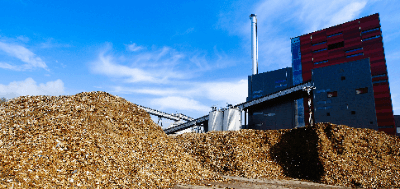What Is a Biomass Power Generator?
 a Biomass Power Generator is a device that generates electricity using biomass resources as fuel.
a Biomass Power Generator is a device that generates electricity using biomass resources as fuel.
Biomass resources are not fossil fuels such as petroleum or coal, but resources derived from reusable plants and animals. Since they do not use fossil fuels, they are attracting attention as eco-friendly generators.
In addition to being carbon neutral, Biomass Power Generators are also characterized by its ability to generate electricity in a stable manner. The reason for this is that, unlike power generation using natural energy, fuel can be obtained in a stable manner.
Uses of Biomass Power Generators
Biomass Power Generators are used for the generation of electricity. They come in a variety of sizes, from relatively small ones used in factories to large ones operated by power companies.
Some of the smaller Biomass Power Generators have a generating capacity of about 50 kW. However, the larger the Biomass Power Generator, the higher the power generation efficiency, and the smaller the generator, the lower the power generation efficiency.
Therefore, when introducing a Biomass Power Generator, it is necessary to consider the power generation efficiency, power generation capacity, and running costs.
Principle of Biomass Power Generator
Biomass Power Generators can be broadly classified into three types according to the principle of power generation: direct combustion, pyrolysis gasification, and biochemical gasification. Since the characteristics differ depending on the power generation principle, it is necessary to select the most suitable method according to the intended use and required power generation capacity.
1. Direct Combustion Method
The direct combustion method uses thinned wood, combustible garbage, waste oil, etc. as fuel for direct combustion. The heat energy generated during combustion is used to boil water and rotate a steam turbine to generate electricity. Generally, thinned wood is cut into small pieces to optimize combustion efficiency.
However, with this combustion method, it is difficult to create a high-temperature environment sufficient to rotate a steam turbine, and the smaller the equipment, the lower the power generation efficiency. For this reason, this power generation method is suited for large-scale equipment. However, the difficulty of procuring fuel for large-scale equipment is an issue.
2. Pyrolysis Gasification
In the pyrolysis gasification method, biomass fuel is heat-treated at high temperature to generate gas, which is then used to rotate a gas turbine to generate electricity. This biomass fuel is made from wood pellets or wood chips processed from thinned wood or wood waste.
One of the characteristics of this power generation method is that it can achieve high combustion temperatures. This makes it an ideal power generation method for small Biomass Power Generators.
3. Biochemical Gasification
The biochemical gasification method differs significantly from other power generation methods in that it uses livestock manure and sewage sludge as raw materials. When these materials are fermented, biogas is generated.
This biogas is used to rotate a gas turbine and generate electricity. The advantages of this method are that biomass, which is difficult to burn, can be used and that high power generation efficiency can be achieved.
Other Information on Biomass Power Generators
1. Ultra-Compact Biomass Power Generator
Ultra-compact Biomass Power Generators are also being developed. An ultra-compact Biomass Power Generator measuring approximately 2.5 meters high x 44.8 meters long x 1.3 meters wide has been developed. Each of these generators can generate 40 kW of power, 100 kW of heat, and approximately 78% energy efficiency, ensuring sufficient efficiency.
2. Power Plant Using Biomass Power Generator
In order for biomass power generation to be a viable business, it is essential to have a system to ensure a stable supply of relatively inexpensive fuel.
Let us look at international trends from the “Renewable Energy World White Paper 2020” published by REN21 (headquartered in France), an international network promoting renewable energies.
Globally, bioenergy continues to grow at a moderate pace, with China being a particularly prominent growth area. Recent growth in China’s bioenergy sector has been significant, and according to REN21 statistics, China has been the world’s largest producer of biomass electricity for three consecutive years from 2017 to 2019.
In Europe, on the other hand, many of the major countries have taken the prescribed path of moving away from coal, and there is a movement to switch to biomass, especially in Nordic countries such as Denmark, where biomass is also a popular heat source for district heat supply.
